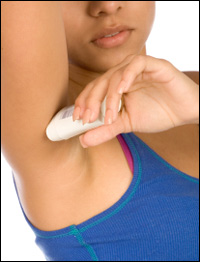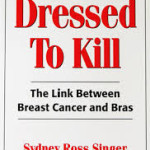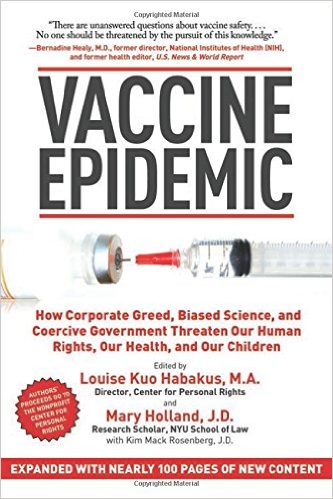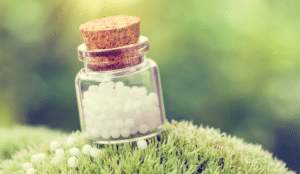If you are using a deodorant or antiperspirant, you have a good reason to ask if it can cause breast cancer. Anything unnatural that you do to your body is a potential cause of disease. Applying chemicals to the armpits, which are next to the breasts, should be suspect.
Whenever you have any health issue, the first thing to ask yourself is:
What am I doing to myself that may be causing the problem?
Our bodies have an innate mechanism for maintaining and recovering health, as long as we don’t get in the way with harmful cultural practices.
We cannot understand breast disease without considering what women do to their breasts. This is a big problem with breast cancer research. Most research ignores the fact that our culture causes us to do things to our bodies that impact our physiology.
 Applying underarm deodorant or antiperspirant affects the breasts because chemicals in these products can enter the breast tissue, which is adjacent to the armpit.
Applying underarm deodorant or antiperspirant affects the breasts because chemicals in these products can enter the breast tissue, which is adjacent to the armpit.
The lymph nodes in the armpit are the primary nodes for breast lymphatic drainage.
Some people have wondered whether blocking sweat glands with antiperspirant reduces the elimination of toxins from the armpit lymph nodes. Actually, the lymph nodes do not connect to the sweat glands. Lymph fluid from the breasts gets filtered in the nodes, and the fluid then travels via lymphatic vessels back to the heart to re-enter the blood circulation. Sweat glands get their fluid from blood capillaries, not from lymphatic vessels or nodes.
This misunderstanding about our anatomy has resulted in some ridicule of the theory that deodorant and antiperspirant use contributes to breast cancer. However, there are other aspects of these products that can be harmful to the breasts. They may contain toxic substances that toxify the breast tissue.
 Many of these products contain parabens, which are estrogen mimics and can stimulate breast cells — including cancer cells — to grow. Aluminum-containing chemicals in antiperspirants, as in aluminum chlorhydrate, also simulate estrogen, and have been found in higher concentrations in the upper outer quadrants of the breasts, near the armpit, making them another cancer suspect.
Many of these products contain parabens, which are estrogen mimics and can stimulate breast cells — including cancer cells — to grow. Aluminum-containing chemicals in antiperspirants, as in aluminum chlorhydrate, also simulate estrogen, and have been found in higher concentrations in the upper outer quadrants of the breasts, near the armpit, making them another cancer suspect.
In addition to parabens and aluminum, there are other toxic components of these products, including triclosan, propylene glycol, Triethanolamine (TEA) and diethanolamine (DEA), and FD&C colors.
If you would not drink these products, then you should not apply them to the skin, where they are absorbed and even stored.
Could these toxins in underarm products be causing breast cancer? A recent study from Scotland suggests that the greatly increased incidence of cancers in the upper outer quadrant of the breast over the past few decades is due to wearing bras, shaving armpits, and using antiperspirants and deodorants.
Shaving armpits increases the ability of chemicals to enter the skin, since it causes micro-abrasions. This can also lead to skin infections. And keep in mind that our bodies have underarm hair to help reduce friction when moving the arm.
There are other problems with antiperspirant use besides toxifying the breast tissue. Sweating is an important form of elimination. Inhibiting this function is not wise, and can lead to an increased toxin load in the body. It can also cause infections as it closes sweat gland pores and can trap bacteria.
Of course, many men wear deodorants and antiperspirants, too, and yet men have only about 1% of the incidence of breast cancer as women.
 The story of toxin exposure to the breasts cannot be fully appreciated without considering something women do to their breasts that men do not.
The story of toxin exposure to the breasts cannot be fully appreciated without considering something women do to their breasts that men do not.
Women wear bras. And bras concentrate toxins in the breasts.
Bras are constrictive garments designed to create an artificial breast shape by applying constant pressure to the delicate breast tissue. This impairs lymphatic drainage from the breasts, resulting in cysts (filled with stagnant lymph fluid), pain, and tissue toxification. This can lead to cancer, since the lymphatic system is part of the immune system and is vital to maintaining health and cleansing the tissues of toxins, including carcinogens.
Our research shows that bra-free women have about the same incidence of breast cancer as men. The tighter and longer the bra is worn, the higher the incidence, rising over 100 times for a 24/7 bra wearer. If you have red marks or indentations in your skin after removing a bra, then it was too tight, and was blocking your lymphatics.
Toxification of the breasts is a key problem. In our petrochemically polluted world, we are exposed to toxins in our food, air, and water, such as pesticides, herbicides, plastics, industrial and automobile exhaust, pharmaceutical drugs, deodorants, and antiperspirants, which need to be cleansed from the body. This process of cleansing relies heavily on the lymphatic system. Impair that cleansing by constricting the breasts with bras, and you get set up for breast disease.
 The toxins are the bullets, and the bra points them directly at the breast by preventing their proper elimination due to constriction. This may be why underarm deodorants and antiperspirants are more hazardous to women than to men.
The toxins are the bullets, and the bra points them directly at the breast by preventing their proper elimination due to constriction. This may be why underarm deodorants and antiperspirants are more hazardous to women than to men.
So anything in your lifestyle that exposes you to toxins in general can contribute to cancer somewhere in your body. Tight clothing then concentrates these toxins in certain organs.
Bras themselves may also contain carcinogens in the fabric, including formaldehyde and 1,3 butadiene, which is a breakdown product of elastic. Bras also contain detergent and fabric softener residues, and remnants of sweat, antiperspirant and deodorant. So the bra can deliver toxins to the breasts in addition to preventing their removal.
There are safe, natural products to deodorize underarms. It would be best to avoid antiperspirants. Of course, if your armpits smell particularly strong it could be a sign of toxicity.
So here is our advice for breast health. Stop wearing tight bras. (Bra-free is best.) Never wear a bra to sleep, and make sure nothing you wear leaves marks in your skin. Use safe, natural products on your skin that you would not mind taking into your body. Avoid underarm shaving and antiperspirants. Avoid toxic chemicals. And, most of all, love yourself and live as natural a lifestyle as you can.
 Sydney Ross Singer and Soma Grismaijer are a husband and wife medical anthropology team, the co-authors of several groundbreaking and controversial health books, and the co-directors of the Institute for the Study of Culturogenic Disease, located in Hawaii. They are internationally recognized for their shocking research linking breast cancer with the wearing of tight bras, which they describe in their book, Dressed To Kill. Their work empowers people to take responsibility for their own health by understanding how their attitudes and behaviors are leading to disease. This enables people to eliminate the harmful lifestyle causes of their problems, giving their bodies a chance to finally heal. Syd and Soma live in Hawaii on a rainforest preserve, which is a wildlife sanctuary and a model of sustainability, where they grow their own food, produce their own energy, and perform lifestyle research on various culture caused diseases. Learn more about their work
Sydney Ross Singer and Soma Grismaijer are a husband and wife medical anthropology team, the co-authors of several groundbreaking and controversial health books, and the co-directors of the Institute for the Study of Culturogenic Disease, located in Hawaii. They are internationally recognized for their shocking research linking breast cancer with the wearing of tight bras, which they describe in their book, Dressed To Kill. Their work empowers people to take responsibility for their own health by understanding how their attitudes and behaviors are leading to disease. This enables people to eliminate the harmful lifestyle causes of their problems, giving their bodies a chance to finally heal. Syd and Soma live in Hawaii on a rainforest preserve, which is a wildlife sanctuary and a model of sustainability, where they grow their own food, produce their own energy, and perform lifestyle research on various culture caused diseases. Learn more about their work
Photo credit: Achieving Adventure













Be safe and use an all-natural product, or make your own at home (there are plenty of DIY recipes online). I prefer to buy my product (www.lavilin.com) at Whole Foods.
Susan… Lavilin has fragrance and other not so safe ingredients. Download the skin deep app.
http://Www.ewg.org/skindeep and see ratings of products
http://www.ewg.org/skindeep/brand/Lavilin/